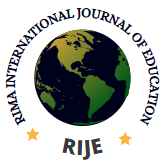Prevalence of Alcohol Consumption and Factors Influencing Alcohol Abuse Among In-School Adolescents in Lagos State, Nigeria: Implications for Prevention Interventions
Osarenren, N., Nwadinigwe, I. P., & Ilugbuhi, M. M
Department of Educational Foundations, Faculty of Education, University of Lagos, Lagos. Nigeria
Abstract
Alcohol is the most common drug of abuse in adolescence, much more than tobacco and other illicit drugs. This study was carried out to examine the prevalence of alcohol consumption and factors influencing alcohol use among in-school adolescents in Lagos metropolis. The study employed a descriptive survey. Four research objectives, four research questions and three research hypotheses were formulated to guide the study. A total of 450 in-school adolescents constituted the respondents. Questionnaires were used to collect relevant data for the study. Data generated and analyzed using the descriptive and inferential statistical methods showed the prevalence of alcohol consumption among in-school adolescents. The Pearson Product Moment Correlation (PPMC) and t-test whereas used to analyze the hypotheses. Findings revealed that alcohol consumption was prevalent. The PPMC analysis revealed a very significant positive correlation between peer pressure and alcohol consumption among in-school adolescents (r=0.816, p=0.001). A significant positive correlation also exists between cheap alcohol and consumption among in-school adolescents (r=0.653, p=0.021), However, a significant gender difference does not exist among in-school adolescents. It was recommended that schools’ curricula should include prevention education based on pro social skills in self-control, decision-making, goal setting, strengthening motivations not to use substances, resisting pro-drug influences, analyzing tobacco and alcohol advertisements. Teachers should be trained on classroom management and improvement programmes that will foster positive and non-threatening climates for school bonding, class attendance, participation and academic progress thereby reducing the consumption of alcohol, other substances and risky behaviours.
Keywords
Prevalence, Adolescents, Alcohol consumption, Prevention, Interventions
Reference
Awusabo-Asare K, Abane A.M, Kumi-Kyereme A. (2004). Adolescent sexual and reproductive health in Ghana: A synthesis of research evidence. New York, NY: Alan Guttmacher Institute.
Crews, F. T., Vetreno, R. P., Broadwater, M. A., & Robinson, D. L. (2016). Adolescent alcohol exposure persistently impacts adult neurobiology and behavior. Pharmacological Reviews, 68(4), 1074–1109. https://doi.org/10.1124/pr.115.011361
Ding, L. (2014). Drinking in context: The influence of peer pressure on drinking among Chinese college students (Publication No. 224) [Doctoral dissertation, University of Nebraska-Lincoln]. Public Access Theses and Dissertations from the College of Education and Human Sciences. http://digitalcommons.unl.edu/cehsdiss/22
Dir, A. L., Bell, R. L., Adams, Z. W., & Hulvershorn, L. A. (2017). Gender differences in risk factors for adolescent binge drinking and implications for intervention and prevention. Frontiers in Psychiatry, 8, 289. https://doi.org/10.3389/fpsyt.2017.00289
Engberg, J., & Morral, A. R. (2006). Reducing substance use improves adolescents’ school attendance. Addiction, 101(12), 1741–1751. https://doi.org/10.1111/j.1360-0443.2006.01544.x
Ekpenyong, M. S., Jagun, H., Stephen, H. A., Bakre, A. T., Odejimi, O., Miller, E., Nyashanu, M., & Bosun-Arije, S. F. (2024). Investigation of the prevalence and factors influencing tobacco and alcohol use among adolescents in Nigeria: A systematic literature review. Drug and alcohol dependence, 256, 111091. https://doi.org/10.1016/j.drugalcdep.2024.111091
Heslin, A. M., & McNulty, B. (2023). Adolescent nutrition and health: characteristics, risk factors and opportunities of an overlooked life stage. Proceedings of the Nutrition Society, 82(2), 142-156.
Hormenu, T., Hagan, J. J., & Schack, T. (2018). Predictors of alcohol consumption among in-school adolescents in the Central Region of Ghana: A baseline information for developing cognitive-behavioural interventions. PLoS ONE, 13(11), e0207093. https://doi.org/10.1371/journal.pone.0207093
Hussong, A. M., Ennett, S. T., Cox, M. J., & Haroon, M. (2017). A systematic review of the unique prospective association of negative affect symptoms and adolescent substance use controlling for externalizing symptoms. Psychology of Addictive Behaviors, 31(2), 137–147. https://doi.org/10.1037/adb0000247
Joanna Q. & Committee on substance use and prevention. (2019). Pediatrics, 144 (1) e20191356; DOI: https://doi.org/10.1542/peds.2019-1356
Jun, H. J., Sacco, P., Bright, C. L., & Camlin, E. A. (2015). Relations among internalizing and externalizing symptoms and drinking frequency during adolescence. Substance Use & Misuse, 50, 1814–1825. https://doi.org/10.3109/10826084.2015.1058826
Marshall, E. J. (2014). Adolescent alcohol use: Risks and consequences. Alcohol and Alcoholism, 49(2), 160–164. https://doi.org/10.1093/alcalc/agt180Marshall, E. J. (2014). Adolescent alcohol use: Risks and consequences. Alcohol and Alcoholism, 49(2), 160–164. doi:10.1093/alcalc/agt180
Ngamije, J., & Yadufashije, C. (2017). Parenting attitude and style and its effects on drug use behavior. SSRN Electronic Journal. https://doi.org/10.2139/ssrn.3036039
Osonuga, O., Ogunmoroti, B. D., Osonuga, A., & Da’costa, A. (2019). Alcohol use among secondary school students in Nigeria: A worrisome trend. New Nigerian Journal of Clinical Research, 8, 54–59.
Olaniyi, A. A., & Jimoh, S. (2021). Factors Associated with Alcohol Consumption among Adolescents in Selected Secondary Schools in a Local Government Area of Oyo State, Southwest, Nigeria. International Journal of Child Health and Nutrition, 10(4), 162–170. https://doi.org/10.6000/1929-4247.2021.10.04.4
Pulliainen, M., & Valtonen, H. (2017). The relationship between alcohol availability and alcohol consumption. Journal of Political Science & Public Affairs, 5, 252. https://doi.org/10.4172/2332-0761.1000252
Richter, L., Pugh, B. S., Peters, E. A., Vaughan, R. D., & Foster, S. E. (2016). Underage drinking: Prevalence and correlates of risky drinking measures among youth aged 12–20. American Journal of Drug and Alcohol Abuse, 42(4), 385–394. https://doi.org/10.3109/00952990.2015.1125492
Siwale, C. C., & Siziya, S. (2019). Factors associated with alcohol consumption among students in high-cost schools in Lusaka, Zambia. International Journal of Translational Medical Research and Public Health, 3(1), 21–30.
Somani, S., & Meghani, S. (2016). Substance abuse among youth: A harsh reality. Emergency Medicine: Open Access, 6(1). https://doi.org/10.4172/2165-7548.1000330
